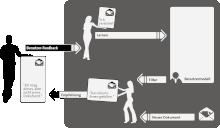Recommendation service
A recommendation service (English Recommender System ) is a software system that has the goal of making a prediction that quantifies how strong the interest of a user is in an object in order to recommend the user exactly the objects from the set of all existing objects, which he is probably most interested in. Typical objects of a recommendation service are, for example, products from a web shop, pieces of music or artists or films. A recommendation service is intended to help cope with the information overload by recommending a subset of a confusing set of objects to the user. A recommendation service uses machine learning and information retrieval methods to determine the appropriate recommendations .
Basics
Recommendation services are always used when there is a large number of objects (e.g. products, pieces of music, films, news articles) from which a small subset is to be recommended to the user. The aim is usually to make it easier for the user to discover objects that are new and interesting for him. The goal of the operator of a recommendation service is to increase sales (e.g. when recommending products) or to increase the number of hits or, in general, to increase the use of his offer.
The simplest type of recommendation service determines further, similar objects for the object currently in use (for example similar news articles to the one that is currently being read). Most of the recommendation services in research consider the user as the central entity for whom a personalized recommendation set is to be determined. For this purpose, the user's interest in objects that have already been used is recorded. Interest in an object is quantified by rating the user. The assessment can be made explicitly or implicitly. In the explicit rating, the user is asked to rate an object, e.g. B. by clicking one to five stars. The implicit determination of the rating is done by analyzing user behavior. In the simplest case, this is a binary evaluation (has used / not used the object). With the help of this evaluation data, similarities between users can be calculated or mathematical models can be learned to predict user interests.
Differentiation according to the data basis
Recommendation services are mainly differentiated according to which data basis they use to determine the amount of recommendation. The two classic types of recommendation services are the content-based (English content-based ) and collaborative (English collaborative ) recommendation services. Other types of recommendation services include e.g. B. the context (context-sensitive recommendation services), the course over time (English time-aware recommender systems ) or demographic data of the user as well as features of the objects.
Content-based recommendation services
Content-based recommendation services recommend items that are similar to the items that the user has already rated highly. For this it is necessary to be able to determine the similarity between two objects.
Collaborative recommendation services
Collaborative recommendation services (also known as collaborative filtering) recommend the objects in which users with similar evaluation behavior ( similar users) are most interested. There is no need to have any further knowledge of the object itself. The recommendation service includes the user-related and element-based algorithm, as well as the model- and memory-based method.
Differentiation according to the basic forecasting method
There are two basic learning methods for recommendation services: memory-based (English memory-based ; also heuristic, English heuristic-based ) and model-based (English model-based ) recommendation services. Memory-based recommendation services use all stored evaluation data to estimate the evaluation of unevaluated user-object combinations with the help of calculated similarity between users or objects. Model-based recommendation services use the evaluation data as learning data in order to use machine learning methods to learn a mathematical model with the help of which a user's interest in an object can be predicted.
Examples of recommendation services
A well-known recommendation engine is that of Amazon.com for recommending book titles and other products. Another example is the BibTip service of the KIT library . In the meantime, numerous German companies use the recommendation function, including Quelle GmbH (before its bankruptcy and the cessation of business operations in 2009), Metro AG and Moviepilot .
Scientific research on recommendation services
The largest international conference on recommendation services is hosted annually by the Association for Computing Machinery .
The US DVD rental company Netflix launched the largest scientific competition in the area of recommendation services in 2006, which was endowed with USD 1 million . The winning solution was delivered in 2009 by a conglomerate called "BellKor's Pragmatic Chaos". Researchers from commendo research & consulting (Austria), AT&T Research (USA), Pragmatic Theory (Canada) and Yahoo! Research (Israel) prevailed against 50,000 competing teams.
See also
- Collaborative filtering
- Catalog enrichment
- Personalization (Information Technology) (Contains overlaps on this topic under "Personalization techniques")
literature
- André Klahold: Recommendation systems. Recommender Systems. Basics, concepts and solutions. Vieweg + Teubner, Wiesbaden 2009, ISBN 978-3-8348-0568-3 ( studies ).
- Dietmar Jannach et al .: Recommender Systems: An Introduction. Cambridge University Press, 2010. ISBN 978-0-5214-9336-9
- Francesco Ricci et al .: Recommender Systems Handbook. Springer, 2011. ISBN 978-0-3878-5819-7
Web links
- The ACM Conference Series on Recommender Systems (English)
- ACM RecSys Wiki (English)
